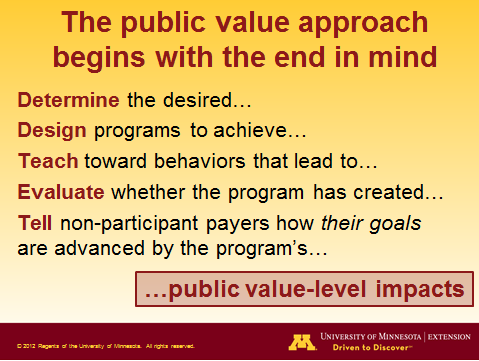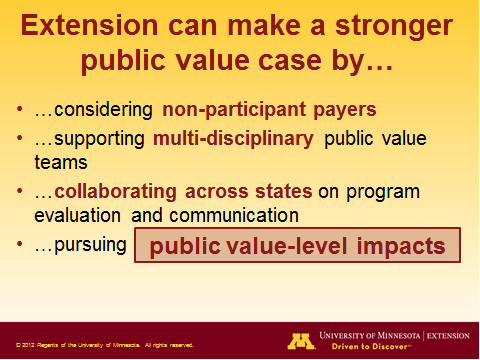Earlier this week I spoke at the 2013 PILD Conference in Alexandria, VA. The title of my talk was “You can understand and effectively communicate the public value of Cooperative Extension,” but once I was done preparing my remarks, the title might as well have been, “In search of the elusive public value-level impacts.”
Because the goal of the public value approach is to persuade stakeholders–specifically, the non-participant payers of Extension programs–we must credibly argue that our programs will lead to impacts that affect the whole community, not only the participants. The Holy Grail of the public value approach, then is public value-level impacts. In the parlance of the UWextension Logic Model, these are long-term outcomes or impacts: Changes in social, economic, environmental, or civic conditions. Improved water quality, reduced public health costs, greater economic vitality and resilience, higher property values, lower taxes, lower crime rates, more effective leadership.
To address this challenge, Extension organizations can begin with the end in mind, where the “end” is those elusive public value-level impacts. The fact is, not all of our programs were designed to achieve condition changes, and few come packaged with evaluation plans designed to document that level of impact. Keeping that need in mind can help us address this deficit as we move forward.
The action steps in the previous slide illustrate the inherent multi-disciplinarity of the public value approach. For each of the action steps, I have listed the skills or disciplines that I thought could contribute to the success of that step. For example, to effectively determine which public value-level impacts to pursue will require experts in community engagement, facilitation, public and legislative relations, and grant-writing as well as the program area’s subject matter scholars. You may disagree with my list or think of others to add. But we can probably agree that if multi-disciplinarity is a key ingredient to developing strong public value messages, then Extension, as a naturally multi-disciplinary system, is well-positioned to create its own future.
Another encouraging observation is that no Extension organization has to tackle the public value challenge alone–nor should it. We are all working on the same action steps for programs that have similarities across states. Working together and sharing ideas across states we can learn the best ways to tackle each of the steps, and make more efficient use of our resources.
Finally, putting these ideas together can help us strengthen Extension’s public value case and contribute to the organization’s sustainability.
Were you at the PILD conference? Do you agree or disagree with my comments? What did I miss that is important to your organization’s ability to make a public value case?



